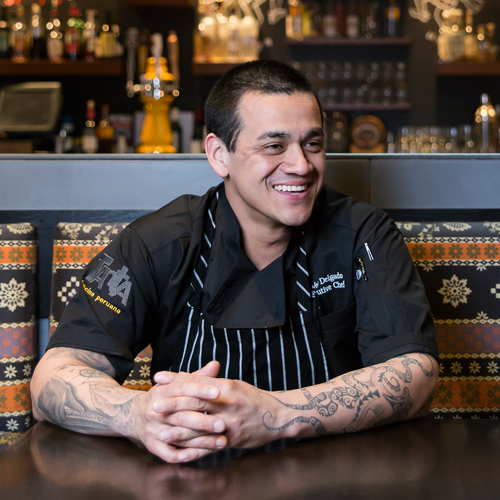
Iconic American brands like Dr Pepper have woken up and smelled the coffee—only to realize that it’s of an increasingly Latin American variety. Endurance and authenticity win the race in Hispanic marketing. And Dr Pepper Snapple Group (DPS) is in it for the long haul, according to Pablo Guzman, vice president of sales, Hispanic markets.
The DPS conglomerate was formed in 2008 from the spin-off of Cadbury Schweppes’ North American beverages business. In addition to Dr Pepper and Snapple, it boasts labels such as 7UP, Mott’s, Canada Dry, Hawaiian Punch, and Peñafiel. Some of its brands, such as Schweppes, trace back centuries.
“When you look at Hispanic culture—whether it’s Puerto Rico, Mexico, or anywhere in Latin America—it’s all very colorful, fun, and festive,” he says. “And that’s what all our flavors are about.”
Secret sauce
Hispanic sales VP Pablo Guzman of Dr Pepper Snapple Group summarizes how to click with Latino shoppers, based on more than three decades of experience in consumer marketing.
Stay in it for the long term
“Latinos are a changing, evolving consumer base. Just look at the strides we’ve made in educational and economic strength. We’re only going to continue to grow and evolve, and if you’ve never established a relationship with us, you’re not going to be able to change with us.”
Be real, be relevant
“Although we may fall under the Hispanic and Latino umbrella, there are many unique points to our cultures—from those who emigrate here, to those who are second and third generation. As companies communicate to us, we don’t want to be patronized or sold. We want to be understood and convinced that what you have for me is good.”
Become part of the familia
“Don’t just sell me things and leave and go home. Get to know my community. Help us progress. Get involved with our education and well-being.”
Marketing pillars and objectives vary for each of DPS’s product lines. For example, Dr Pepper itself—one of more than 50 brands under the DPS flag—historically has not been widely consumed by Hispanics. So in that case, Guzman and his team push campaigns to drive trial. “We believe that when they try us, they will like us,” Guzman says.
Since joining DPS in 2012, Guzman has made it a priority to position the company’s brands in front of Hispanic retailers who may not consider them top-of-mind, and conversely, to promote to mass-market outlets containing unique assortments of product that are proven to resonate with Hispanic shoppers. Like all big business programs, this change starts from the inside.
“What my team is trying to do is incorporate the fact that the Hispanic consumer needs to be part of everyday culture within the organization. It’s not just an initiative—this consumer base is part of our selling culture,” Guzman says. “That’s where my work as a cheerleader or evangelist really helps.”
Guzman, born in El Paso, Texas, to immigrants from Mexico, spent more than 30 years working at MillerCoors. There, he led a national go-to-market strategy for Latinos, which gave him insight into the sales dynamics of various geographic and cultural pockets across the country. When MillerCoors decided to relocate him in 2008, Guzman made the tough choice to step down so that the middle of his three sons would not be uprooted from high school.
Guzman, along with his siblings, was the first generation in his family to attend college. He obtained a degree in business administration, and education remains one of his passion points. His eldest two sons are now Stanford and Harvard alums, respectively.
Guzman has refined DPS’s vision for capturing Hispanic market share, stretching beyond dollars and cents (and pesos). Along with his leadership team, he has made it a personal mission for key DPS brands to become a centerpiece not just on the Hispanic dinner table but in Hispanic life.
Latino marketing in a box (or can)
While Hispanic beverage sales trended down by 1.2 percent according to recent Nielsen ratings, DPS grew its volume greater than two times the category trend over the same year period. Guzman and team are supporting this growth by executing a three-pronged strategy to become ingrained in Latino communities.
Strategy 1: Communicate in a culturally relevant manner
Cultural relevance is more than internal language communication across all channels, which DPS does as a basic measure for all brands courting Hispanic customers. Yet “relevance” transcends words. “I work with the marketing team to help them develop content so that it resonates not just as a selling message but utilizing a 360 degree viewpoint to connect with the consumer,” he says.
Take the 7UP brand, which is reinventing itself and turning up the volume with bicultural millennials. Previously targeting the 35 and older general market crowd, the label is now pivoting toward twenty-something Hispanics. Its new messaging is rooted in optimism—reflecting millennial aspirations—with a platform spun on electronic dance music. Sponsorships such as Miami’s Ultra Music Festival offer music fans the chance to make memories with 7UP.
Studies show that consumers are feeling the beat. Custom research uncovered an uptick in Hispanic electronic dance music fans’ perception: they found 7UP more modern, more optimistic, and more “cool” after the launch of the new brand campaign, as compared to the previous brand strategy. In addition, 7UP’s Hispanic growth outpaced the lemon-lime category overall in 2014 and continued its expansion in 2015.
Clamato, a tomato concentrate juice drink with a long Hispanic legacy, also is skewing toward younger Hispanic shoppers. Traditionally catering to a broad spectrum of 21-to-39-year-olds, now it’s laser-focused on the entry segment within that range.
“In our social and digital media, we’ve created content videos that cleverly show how to make the very popular michelada, which is Clamato mixed with beer,” Guzman says. Online content also includes recipes infused with Latino roots—for example, how to use Clamato to spice up a fish platter, pescado a la Veracruzana.
The latest Clamato innovation takes the michelada phenomenon (which is popular across Latin America and the US) one step further. “Our new Clamato Preparado conveniently gives consumers all the ‘mixings’ they need for their michelada in our bottle, so they don’t have to add their own spices,” Guzman says.
Catering to customers seeking a ready-made package, Clamato and Budweiser have partnered to serve up the pre-mixed, fully loaded Chelada, which has enjoyed steady growth in the Hispanic market over the past three years.
Strategy 2: Execute at retail with Latino-centric focus
Guzman’s sales team of nineteen employees, divided across five US regions, uses a census-level data tool to hone in on where Hispanic consumers live and which items are hot. Then, the teams build out product displays to sell to stores, appealing directly to that lightning-rod profile. They identify stores where the program will get the most traction and, when possible, tie to a sweepstakes or promotion headlined by Latino talent, such as a concert series. All of these forces combine to ramp up Latino sales.
The sales force takes on an educational role, informing the retailer about which mix will drive the most impact. “It provides an opportunity, not just for the consumer shopping in Hispanic grocery stores but also in the Krogers and Walmarts of the world,” he says.
Listening to Guzman describe Latino retail is like watching a child roam avidly through a candy shop. He loves the Hispanic shopping experience and he knows it inside and out. Even after a few decades, he finds a thrill of discovery within it.
“When you walk into a Hispanic grocery store, you get hit by all five senses,” Guzman says. “If it’s not the panadería, it’s the tortillería. And your eyes are looking at a bright and colorful store, whether it’s the piñata or varied produce from different countries. So you’ve got all these scents and colors, then you hear the Latin music going. There are tons of displays you can touch and demos where you can actually taste new foods.”
That five-sense framework can sell for Latinos in any store, bodega, or big box, he says.
Strategy 3: Become part of the fabric of Hispanic communities
To embed itself into the culture, Dr Pepper Snapple Group goes grassroots—improving communities and offering opportunities for the next generation.
Since 2011, DPS has committed more than $28 million to its philanthropic initiative, “Let’s Play,” an international platform spanning the United States, Mexico, Puerto Rico, and Canada. Its primary US partner is KaBOOM, a nonprofit seeking to put a playground within walking distance of every family in America. The company has involved thousands of employees in more than 50 playground builds in recent years, many of which are in Hispanic neighborhoods. These projects benefit schools and local nonprofits such as the Boys & Girls Club, The Salvation Army, and myriad other community organizations.
Another partnership is with Good Sports, an organization that helps sustain athletic leagues, serving youths across the country through grants for sports equipment, uniforms, gear, balls, bats, and helmets.
“Through Let’s Play, we’re building play structures, swing sets, monkey bars, and slides,” Guzman says, “but eventually you outgrow the playground. Then Good Sports appeals to kids slightly older, encouraging them to get involved in athletics.”
The key is longevity, Guzman adds. “We’re a very trusting yet cautious culture. If you’re just in and out, then we know there is no commitment there.”

